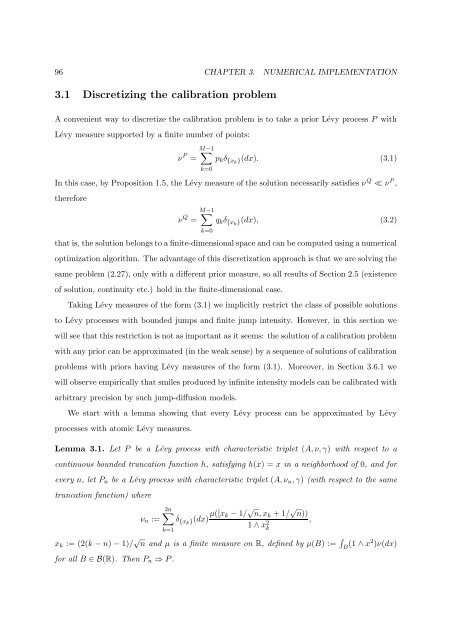Processus de Lévy en Finance - Laboratoire de Probabilités et ...
Processus de Lévy en Finance - Laboratoire de Probabilités et ...
Processus de Lévy en Finance - Laboratoire de Probabilités et ...
Create successful ePaper yourself
Turn your PDF publications into a flip-book with our unique Google optimized e-Paper software.
96 CHAPTER 3. NUMERICAL IMPLEMENTATION<br />
3.1 Discr<strong>et</strong>izing the calibration problem<br />
A conv<strong>en</strong>i<strong>en</strong>t way to discr<strong>et</strong>ize the calibration problem is to take a prior Lévy process P with<br />
Lévy measure supported by a finite number of points:<br />
ν P =<br />
M−1<br />
∑<br />
k=0<br />
p k δ {xk }(dx). (3.1)<br />
In this case, by Proposition 1.5, the Lévy measure of the solution necessarily satisfies ν Q ≪ ν P ,<br />
therefore<br />
ν Q =<br />
M−1<br />
∑<br />
k=0<br />
q k δ {xk }(dx), (3.2)<br />
that is, the solution belongs to a finite-dim<strong>en</strong>sional space and can be computed using a numerical<br />
optimization algorithm. The advantage of this discr<strong>et</strong>ization approach is that we are solving the<br />
same problem (2.27), only with a differ<strong>en</strong>t prior measure, so all results of Section 2.5 (exist<strong>en</strong>ce<br />
of solution, continuity <strong>et</strong>c.) hold in the finite-dim<strong>en</strong>sional case.<br />
Taking Lévy measures of the form (3.1) we implicitly restrict the class of possible solutions<br />
to Lévy processes with boun<strong>de</strong>d jumps and finite jump int<strong>en</strong>sity. However, in this section we<br />
will see that this restriction is not as important as it seems: the solution of a calibration problem<br />
with any prior can be approximated (in the weak s<strong>en</strong>se) by a sequ<strong>en</strong>ce of solutions of calibration<br />
problems with priors having Lévy measures of the form (3.1). Moreover, in Section 3.6.1 we<br />
will observe empirically that smiles produced by infinite int<strong>en</strong>sity mo<strong>de</strong>ls can be calibrated with<br />
arbitrary precision by such jump-diffusion mo<strong>de</strong>ls.<br />
We start with a lemma showing that every Lévy process can be approximated by Lévy<br />
processes with atomic Lévy measures.<br />
Lemma 3.1. L<strong>et</strong> P be a Lévy process with characteristic tripl<strong>et</strong> (A, ν, γ) with respect to a<br />
continuous boun<strong>de</strong>d truncation function h, satisfying h(x) = x in a neighborhood of 0, and for<br />
every n, l<strong>et</strong> P n be a Lévy process with characteristic tripl<strong>et</strong> (A, ν n , γ) (with respect to the same<br />
truncation function) where<br />
ν n :=<br />
2n∑<br />
k=1<br />
δ {xk }(dx) µ([x k − 1/ √ n, x k + 1/ √ n))<br />
1 ∧ x 2 ,<br />
k<br />
x k := (2(k − n) − 1)/ √ n and µ is a finite measure on R, <strong>de</strong>fined by µ(B) := ∫ B (1 ∧ x2 )ν(dx)<br />
for all B ∈ B(R). Th<strong>en</strong> P n ⇒ P .
















